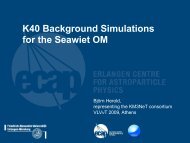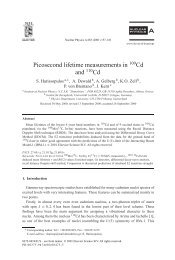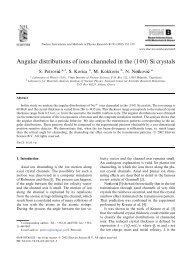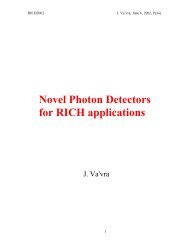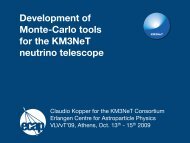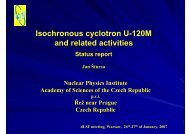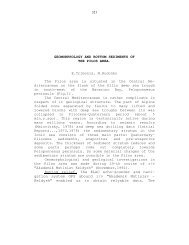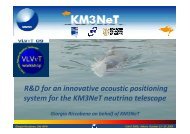"Operation and performance of the NESTOR test detector" Nucl.Instr ...
"Operation and performance of the NESTOR test detector" Nucl.Instr ...
"Operation and performance of the NESTOR test detector" Nucl.Instr ...
You also want an ePaper? Increase the reach of your titles
YUMPU automatically turns print PDFs into web optimized ePapers that Google loves.
ARTICLE IN PRESS<br />
G. Aggouras et al. / <strong>Nucl</strong>ear <strong>Instr</strong>uments <strong>and</strong> Methods in Physics Research A 552 (2005) 420–439 429<br />
<strong>of</strong> <strong>the</strong>se events are due to r<strong>and</strong>om coincidences <strong>of</strong><br />
pulses from K 40 decays. The emitted electrons<br />
produce Cherenkov light at <strong>the</strong> level <strong>of</strong> few<br />
photoelectrons. The corrected pulse height distribution<br />
is in a very good agreement with <strong>the</strong><br />
results <strong>of</strong> <strong>the</strong> calibration data accumulated in <strong>the</strong><br />
laboratory before <strong>the</strong> deployment <strong>of</strong> <strong>the</strong> detector<br />
(see Section 6).<br />
For <strong>the</strong> rest <strong>of</strong> this paper whenever pulse-heights<br />
are presented, <strong>the</strong>y have been corrected using <strong>the</strong><br />
outlined procedure (unless o<strong>the</strong>rwise noted).<br />
5. Detector simulation<br />
We have developed a simulation package that<br />
describes in detail <strong>the</strong> detector architecture <strong>and</strong> its<br />
functionality, as well as <strong>the</strong> physical processes<br />
related to an underwater neutrino telescope. It was<br />
extensively used for studying <strong>the</strong> overall <strong>performance</strong><br />
<strong>of</strong> <strong>the</strong> detector <strong>and</strong> data analysis. The<br />
simulation process consists <strong>of</strong> two phases. In <strong>the</strong><br />
first phase, we simulate <strong>the</strong> physical processes<br />
resulting in <strong>the</strong> production <strong>of</strong> Cherenkov photons<br />
<strong>and</strong> <strong>the</strong> propagation <strong>of</strong> <strong>the</strong> photons through <strong>the</strong><br />
water <strong>and</strong> <strong>the</strong> materials surrounding <strong>the</strong> pmt [21]<br />
until <strong>the</strong>y arrive at <strong>the</strong> photo-cathode. In <strong>the</strong><br />
second phase we simulate in detail <strong>the</strong> pmt<br />
response, <strong>the</strong> functions <strong>of</strong> <strong>the</strong> electronics <strong>and</strong> <strong>the</strong><br />
data acquisition system.<br />
In <strong>the</strong> first simulation phase, all known processes<br />
that can occur when a neutrino interacts or<br />
when a charged lepton passes through <strong>the</strong> matter<br />
surrounding <strong>the</strong> detector are included. Since <strong>the</strong><br />
signal is produced by <strong>the</strong> Cherenkov photons that<br />
hit <strong>the</strong> photocathode <strong>of</strong> <strong>the</strong> pmts, special attention<br />
is given to <strong>the</strong> Cherenkov radiation <strong>and</strong> <strong>the</strong><br />
propagation <strong>of</strong> light in <strong>the</strong> water <strong>and</strong> through<br />
<strong>the</strong> Optical Module. The tool used in this stage is<br />
<strong>the</strong> GEANT 4 simulation package [26] <strong>and</strong> its<br />
interfaces with o<strong>the</strong>r packages such as Pythia [36],<br />
EGS [37], etc. All <strong>the</strong> energy losses <strong>of</strong> <strong>the</strong> particles<br />
involved (ionization, atomic excitation, bremsstrahlung,<br />
pair production, muon–nucleus interaction,<br />
formation <strong>of</strong> electromagnetic <strong>and</strong> hadronic<br />
showers, etc.) as well as multiple scattering are<br />
taken into account. The simulation package tracks<br />
every primary <strong>and</strong> secondary particle between<br />
consecutive interactions. At each stepCherenkov<br />
photons are generated, which may interact ei<strong>the</strong>r<br />
by absorption, or by scattering in <strong>the</strong> water, before<br />
<strong>the</strong>y reach <strong>the</strong> Optical Module. The Optical<br />
Module [21] consists <strong>of</strong> many components, which<br />
are described in detail in <strong>the</strong> simulation. For this<br />
we used a geometrical description <strong>of</strong> <strong>the</strong> benthos<br />
sphere (<strong>the</strong> glass housing <strong>of</strong> <strong>the</strong> pmt), <strong>the</strong> glycerine<br />
(<strong>the</strong> optical coupling between <strong>the</strong> glass envelope<br />
<strong>and</strong> <strong>the</strong> pmt) <strong>and</strong> <strong>the</strong> shading caused by <strong>the</strong><br />
magnetic shielding cage. The optical properties <strong>of</strong><br />
each component, such as <strong>the</strong> absorption length<br />
<strong>and</strong> <strong>the</strong> refractive index, are taken as a function <strong>of</strong><br />
<strong>the</strong> photon wavelength.<br />
The second phase includes <strong>the</strong> generation <strong>of</strong><br />
single electrical pulses, <strong>the</strong> contribution <strong>of</strong> <strong>the</strong><br />
background sources, <strong>the</strong> generation <strong>of</strong> <strong>the</strong> pmt<br />
waveforms <strong>and</strong> <strong>the</strong> functions <strong>of</strong> <strong>the</strong> electronics.<br />
The simulation in this phase is based on <strong>the</strong><br />
following assumptions:<br />
(a) The emission <strong>of</strong> photoelectrons is a stochastic<br />
process. Each photon <strong>of</strong> a certain wavelength<br />
(l) liberates an electron from <strong>the</strong> photocathode<br />
according to <strong>the</strong> probability that is <strong>the</strong> product<br />
<strong>of</strong> <strong>the</strong> quantum efficiency <strong>of</strong> <strong>the</strong> photocathode<br />
at wavelength l <strong>and</strong> <strong>the</strong> collection efficiency,<br />
which depends on <strong>the</strong> position where <strong>the</strong><br />
photon hits <strong>the</strong> photocathode [21].<br />
(b) Each emitted photoelectron produces a single<br />
electrical pulse at <strong>the</strong> anode with amplitude<br />
that follows <strong>the</strong> one-photoelectron pmt pulse<br />
height distribution; this has been measured in<br />
<strong>the</strong> laboratory for each individual pmt.<br />
(c) The functional form, which describes <strong>the</strong><br />
electrical pulse shape, was defined by fitting<br />
digitized pmt pulses measured in <strong>the</strong> laboratory.<br />
(d) The transition time <strong>of</strong> <strong>the</strong> pmt pulses varies<br />
according to a Gaussian distribution measured<br />
for each pmt separately [21].<br />
(e) The pmt response to ‘n’ photoelectrons is a<br />
linear sum <strong>of</strong> <strong>the</strong> pulses simulated for each<br />
individual photoelectron.<br />
(f) Background pulses due to <strong>the</strong>rmionic noise<br />
<strong>and</strong> <strong>the</strong> after <strong>and</strong> late pulses <strong>of</strong> <strong>the</strong> pmt are<br />
added to each event. The characteristics <strong>of</strong> <strong>the</strong><br />
first contribution (<strong>the</strong> pulse height distribu-



